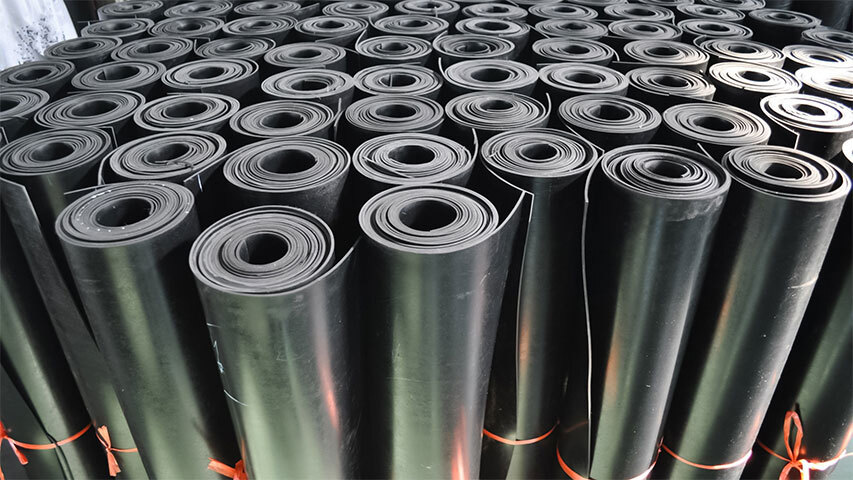Removing VOCs in the rubber industry
Companies across Europe are increasingly putting sustainability principles at the heart of their business models and seeking new ways to reduce their environmental impact. Yet cost-effectiveness is also a concern, with companies understandably reluctant to make major investments where only a temporary solution may be required. DESOTEC’s mobile activated carbon filters can be tested thoroughly and installed swiftly, providing companies with straightforward solutions to contamination problems.
The problem
A company in France makes rubber products. Hydrocarbon solvents are used during the vulcanisation process, releasing potentially harmful Volatile Organic Compounds (VOCs).
Production rose to meet increased demand in 2020. The company was then issued with a formal notice to reduce its emissions by 2022, and ordered to present the environmental authorities with an action plan by the start of 2021.
The company is deeply committed to its environmental strategy, and eager to comply. It worked with an engineering consultancy, who advised that the best long-term solution would be a Regenerative Thermal Oxidiser (RTO) with a capital expenditure of around two million euros.
However, there are plans for a major overhaul of the factory in the coming years, so the company is reluctant to make a major investment in a new RTO at this point. Especially, as it is also seeking an alternative for the solvent which could change the purification need drastically.
The consultancy raised the possibility of activated carbon filtration so the client contacted DESOTEC looking for a temporary, adaptable solution with minimal capital expenditure.

The solution
There are several points of air emissions at the plant, corresponding to different stages of the production process such as gluing, drying and varnishing. Most are already fitted with extraction systems like fans and ducts, but some are not.
The company proposed starting with those outlets with existing extraction systems, to check that activated carbon was effective before investing in new pipes and fans.
The first phase would involve a flow rate of 12 000 m³/h with a VOC concentration of 300 mg/m³, over eight hours per day.
Later phases would see flow rates of 2-16 000 m³/h, depending on which part of the installation was in operation.
Therefore, the filtration solution would have to be adaptable to different flow rates, which always presents a challenge.
DESOTEC agreed to carry out a pilot at the site using an AIRCON 2000 skid – a complete test unit that includes a fan, pipework and filter – on a 2 000m³/h flow.
After several weeks of tests, we are now proposing to install two AIRCON V-XL units in series to treat all the different flow rates combined.
As the VOCs are flammable, we also propose to install an ‘INERTI-BOX’: a solution that we have developed ourselves. This incorporates a carbon monoxide detector to see if hotspots are developing within the filter bed. If so, the filter valves are closed, and the filter doused in nitrogen to prevent a fire.
The results
This is a major project, and tests will continue for another few weeks. However, the activated carbon is already proving highly effective in capturing the VOCs.
The client is now preparing its action plan for the environmental authority, and DESOTEC is ready to deliver and install the filters as soon as it is given the go-ahead.
This case study demonstrates the thorough testing regime that DESOTEC carries out, which is particularly important for major projects facing strict deadlines.
The client has been very satisfied by the flexibility of our full-service solution, which can adapt to very varied flow rates.
It also appreciates the low level of investment required, given that this is intended to be only a temporary solution. However, it is possible that activated carbon could be installed at this plant in the long term.
The client is also impressed by our commitment to reactivating spent carbon, which aligns with its own sustainability principles. We transport the closed filter units safely to our site in Belgium, where we test samples to determine how to store and treat the carbon. All molecules that were adsorbed onto the filters are desorbed in our reactivation furnaces, then destroyed in an incineration and neutralisation set-up in accordance with national and EU legislation. The entire installation and its emissions are under continuous online monitoring, which guarantees that only harmless water vapour exits the chimneys.
Contact DESOTEC today
To discuss how DESOTEC’s mobile activated carbon filtration could solve your site’s contamination issues, contact our team of expert engineers today.
Contact our expertsContact DESOTEC today
To discuss how DESOTEC’s mobile activated carbon filtration could solve your site’s contamination issues, contact our team of expert engineers today.
Contact our experts-
Air & gas purification
Our sustainable filtration solutions ensure air purification, odour control, and high quality process gases such as biogas and biomethane. -
Our unique service
Our closed-loop, full-service model is as unique as your business needs. We’ll define the right filtration setup and safely recycle filtration waste, making it easy to go green. -
Your sustainability journey
We care about protecting our air, water and soil for future generations, just like you. Our filtration solutions help you meet environmental standards, reducing your carbon footprint.


